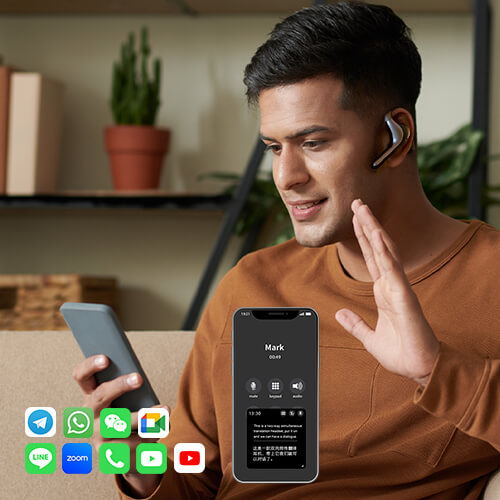
10 Proven Ways to Break Down Language Barriers and Communicate Effectively
Language barriers affect millions of people worldwide every day, causing frustration and lost opportunity. Whether you are a business executive, student, or tourist, these communication barriers can appear daunting, but here is the good news: you can turn these barriers into real opportunities for connection by using the right strategies.
In this guide, we'll review field-tested, tried-and-true techniques for bridging language gaps and communicating cross-culturally. They're not theoretical concepts - they're practical applications that have been tested.
When Language Barriers Create Real Problems
In Workplace
The work environment is becoming more diverse. Recent studies on work have shown that organizations that have multilingual workers see 19% revenue increases. But communication barriers can counteract the benefits.
Dozens of brilliant ideas are lost into thin air at group meetings. One of them was one of our own software professionals who failed to get promoted as he was not able to present his technical skills in English while making a presentation. He was extremely brilliant, but the language barrier blurred his potential.
These workplace language challenges often manifest as:
- Misunderstood project requirements
- Reduced participation in brainstorming sessions
- Difficulty building relationships with colleagues
- Missed networking opportunities
While Traveling Abroad
Travel should always be an occasion of exploration and adventure, not of communication anxiety. Yet differences in language can turn an adventurous journey into stress.
Have you ever been traveling and found yourself looking for a hotel but couldn't correctly convey the address to the taxi driver? What should have been a simple 15-minute journey can end up costing you a lot of communication time, and you might not even reach your desired destination.
Common travel communication challenges include:
- Navigation and transportation confusion
- Ordering food and dietary restrictions
- Emergency situations requiring immediate help
- Missing cultural experiences due to communication gaps
In Educational Environments
When academic problems are combined with language barriers, international students face issues of an extraordinary kind. Many international students see communication problems as their greatest challenge of adaptation.
Most of these international learners grasp class material well but do not effectively participate in class discussions. Poor grades do not derive from insufficient knowledge, yet from lack of confidence articulating their ideas on their feet when they are face-to-face with others.
Related Reading: How Students Use Translation Earbuds for Studying Abroad?
How to Support ESL Students in the Classroom?
Academic language barriers often involve:
- Complex academic vocabulary and concepts
- Participation in group projects and presentations
- Building relationships with professors and peers
- Understanding cultural context in discussions
In Personal Relationships
Love may be universal, but expressing it across languages requires skill and patience. Inter-cultural couples have problems generally with common communication which is beyond the vocabulary.
Foreign couples may at times misinterpret each other's emotional expressions and sense of humor in their daily life. At times cross-cultural misunderstandings unnecessarily raise tension between them.
Relationship language barriers include:
- Expressing emotions and feelings accurately
- Understanding cultural humor and references
- Navigating family interactions and traditions
- Resolving conflicts effectively
In Churches
Religious groups are normally organized under shared faiths, but language variations will usually cause the members not to participate completely. Sermons are conducted personally with a single dominating language for most foreign churches, so the foreigners could not keep up. At this time, some professional translation equipment comes in handy.
For example, during community events, there are members who will miss essential details on community activities or charity work because they do not understand announcements. This denies them the chance of fully taking part in spiritual and social events.
Church-related language barriers often include:
- Difficulty understanding sermons, hymns, and prayers
- Missing important community announcements and activities
- Struggles in building fellowship with diverse members
- Limited participation in volunteering or outreach programs
On Construction Sites
Most of the construction activity will comprise workers from different countries, who will also have different languages. Effectiveness, safety, and cooperation are highly dependent upon good communication, yet language barriers can create serious risks.
For one, there will be safety procedures given by the foreman in English, yet workers speaking Spanish or Mandarin will not receive essential warnings. Projects do not only get delayed, but lives are also on the line.
Construction site language barriers often include:
- Misunderstood safety protocols and procedures
- Errors in following technical plans or blueprints
- Reduced collaboration between multinational teams
- Higher risk of workplace accidents due to poor communication
10 Expert Strategies to Overcome Language Barriers

1. Prepare Before You Communicate
Smart preparation prevents most communication disasters. Before entering any situation where language might be challenging, invest time in research and planning.
Create a communication toolkit by identifying key phrases you'll likely need. If you're attending a business conference, learn industry-specific terms. For travel, focus on essential survival phrases like directions, food, and emergencies.
Research cultural communication styles too. Some cultures value direct communication, while others prefer indirect approaches. Understanding these differences prevents misunderstandings before they happen.
Pro tip: Write down important phrases phonetically if the writing system is unfamiliar. This helps with pronunciation and builds confidence.
2. Leverage Translation Technology Wisely
Modern translation apps are powerful tools, but they're not magic solutions. Google Translate, Microsoft Translator, and similar apps work best for basic communication, not complex conversations. You can also invest in a professional Timekettle translation device like the X1, which is widely used in teaching, churches, construction, business meetings and other scenarios, allowing you to freely deal with language barriers.

Use technology strategically:
- Translate key nouns and verbs rather than complete sentences
- Verify translations by translating back to your original language
- Learn to use offline features for areas with poor internet
- Combine apps with gestures and visual cues
Remember that translation apps struggle with context, idioms, and cultural nuances. They're excellent backup tools but shouldn't be your only communication strategy.
3. Master Essential Survival Phrases
Learning a few key phrases in someone's native language shows respect and opens doors to better communication. You don't need fluency – even basic attempts are appreciated.
Focus on these universal conversation starters:
- Greetings and polite expressions
- "Please speak slowly"
- "I don't understand, can you repeat that?"
- "How do you say..."
- Basic questions (where, when, how much)
The psychological impact is significant. When you attempt to speak someone's language, they become more patient and helpful with your communication efforts.
4. Invest in Professional Language Coaching
If language barriers regularly impact your life, working with a qualified tutor provides the fastest improvement. Unlike generic language apps, professional instructors customize lessons to your specific needs.
A good language coach will:
- Assess your current communication challenges
- Create targeted lessons for your situation
- Practice real-world scenarios through role-play
- Provide immediate feedback on pronunciation and grammar
- Build your confidence through structured practice
Many professionals see dramatic improvements after just a few focused sessions. The investment pays off quickly in improved job performance, travel experiences, and personal relationships.
5. Eliminate Confusing Language Elements
When communicating across language barriers, clarity trumps sophistication. Avoid these common communication traps:
Idioms and expressions: "It's raining cats and dogs" means nothing to non-native speakers. Say "It's raining heavily" instead.
Slang and colloquialisms: Regional expressions confuse people. Use standard language that translates better.
Cultural references: Movie quotes, historical references, and pop culture jokes don't translate across cultures.
Sarcasm and humor: These rely heavily on cultural context and tone, making them risky in cross-cultural communication.
6. Simplify Your Language Structure
Complex grammar structures make understanding difficult, even for advanced language learners. Adopt these simplification strategies:
Use active voice instead of passive voice:
- Instead of: "The report should be completed by Friday"
- Say: "Please finish the report by Friday"
Choose simple verb tenses:
- Avoid: "I would have been thinking about going"
- Use: "I want to go"
Break complex ideas into smaller parts:
- Instead of one long explanation, use several short sentences
- Pause between ideas to allow processing time
- Check understanding frequently
7. Speak Clearly and Deliberately
Your speaking style dramatically affects comprehension. Native speakers often talk too fast and mumble words together, making understanding nearly impossible for language learners.
Implement these speaking techniques:
- Reduce your speaking speed by 25%
- Pronounce each word distinctly
- Pause between sentences
- Emphasize important words slightly
- Use consistent volume and tone
Think of yourself as a news anchor – clear, deliberate, and easy to understand. This isn't talking down to someone; it's being considerate of their learning process.
8. Harness Visual Communication Power
When words fail, pictures succeed. Visual communication transcends language barriers and often conveys meaning more effectively than verbal explanations.
Effective visual communication includes:
- Drawing simple diagrams or maps
- Using photos on your phone to show what you mean
- Pointing to objects and locations
- Using hand gestures (but research cultural appropriateness first)
- Facial expressions to convey emotions
Many successful international business deals have been closed using napkin drawings and simple sketches when language failed.
9. Decode Non-Verbal Communication Signals
Body language speaks volumes, especially when verbal communication is limited. Become a better observer of non-verbal cues to improve your communication success.
Watch for these important signals:
- Facial expressions indicating confusion or understanding
- Posture changes showing comfort or discomfort
- Eye contact patterns (varies by culture)
- Hand gestures and their meanings
- Personal space preferences
When you notice confusion, address it immediately: "I can see you're not sure about this. Let me explain it differently."
10. Engage Professional Interpretation Services
Some situations require professional help. Don't hesitate to use interpretation services when stakes are high or communication is critical.
Consider professional interpreters for:
- Legal documents and proceedings
- Medical appointments and procedures
- Important business negotiations
- Educational assessments and meetings
- Government services and applications
Modern technology makes interpretation services more accessible and affordable. Many services offer remote interpretation via video calls, making professional help available anywhere.
Transform Your Communication with Targeted Learning
Breaking down language barriers isn't just about learning vocabulary – it's about building bridges between cultures and relationships that matter. The best approach is to blend a range of strategies tailor-made to your situation.
Whether for working outside the country on a work project, new employment with employees of a different culture, or establishing relationships with people of a different culture, consistent practice and sufficient support matter a lot.
Keep in mind that all the professionals got their start somewhere. It just needs the correct beginning and regular practice with your training.
Frequently Asked Questions
How long does it take to overcome basic language barriers?
Intensive use will have the diligent student able to cope with simple communication situations in 2-3 months. Depending, of course, on languages studied, learning ability, and level of self-practice which one achieves, of course. Study with a tutor privately will usually accelerate proceedings significantly.
Are translation apps reliable for important conversations?
Translation apps are helpful for basic communication but aren't reliable for complex or important discussions. They struggle with context, cultural nuances, and technical terminology. Use them as support tools, but don't rely on them exclusively for critical communications.
What's the most important phrase to learn in any language?
"I don't understand, please speak slowly" is universally valuable. It will instantly convey your location and will have the tendency of making the other person talk more patiently and slowly.
How can I practice language skills without traveling abroad?
Look for language exchange clubs locally, and participate in internet chat rooms, watch movies from other countries with subtitles, and communicate with native speakers through video conferencing programs. Every major city has multicultural communities where you can practice with real-life situations.
Should I learn formal or conversational language first?
Start with informal speech for daily communication and use formal speech as necessary for professional communication. Informal speech offers the means of interacting with people and handling daily tasks and helps to prepare the way for more formal communication ahead.






















